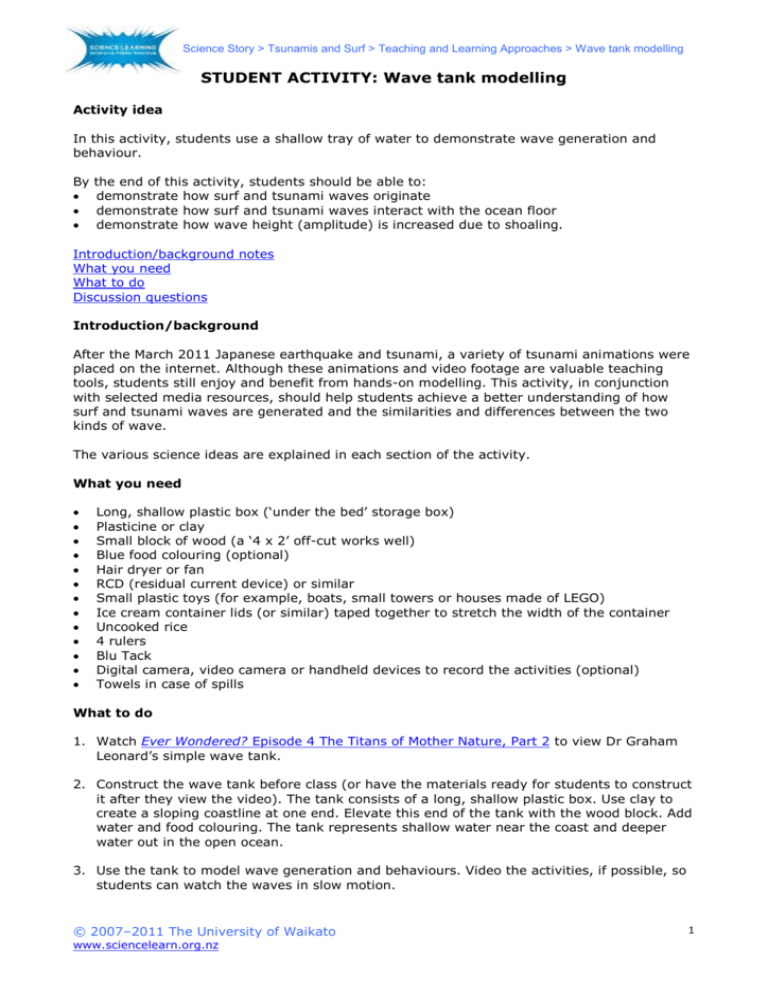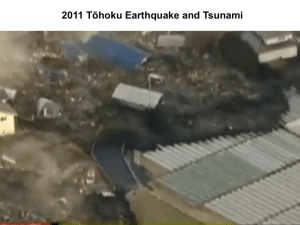Wave tank modelling
advertisement

Science Story > Tsunamis and Surf > Teaching and Learning Approaches > Wave tank modelling STUDENT ACTIVITY: Wave tank modelling Activity idea In this activity, students use a shallow tray of water to demonstrate wave generation and behaviour. By the end of this activity, students should be able to: demonstrate how surf and tsunami waves originate demonstrate how surf and tsunami waves interact with the ocean floor demonstrate how wave height (amplitude) is increased due to shoaling. Introduction/background notes What you need What to do Discussion questions Introduction/background After the March 2011 Japanese earthquake and tsunami, a variety of tsunami animations were placed on the internet. Although these animations and video footage are valuable teaching tools, students still enjoy and benefit from hands-on modelling. This activity, in conjunction with selected media resources, should help students achieve a better understanding of how surf and tsunami waves are generated and the similarities and differences between the two kinds of wave. The various science ideas are explained in each section of the activity. What you need Long, shallow plastic box (‘under the bed’ storage box) Plasticine or clay Small block of wood (a ‘4 x 2’ off-cut works well) Blue food colouring (optional) Hair dryer or fan RCD (residual current device) or similar Small plastic toys (for example, boats, small towers or houses made of LEGO) Ice cream container lids (or similar) taped together to stretch the width of the container Uncooked rice 4 rulers Blu Tack Digital camera, video camera or handheld devices to record the activities (optional) Towels in case of spills What to do 1. Watch Ever Wondered? Episode 4 The Titans of Mother Nature, Part 2 to view Dr Graham Leonard’s simple wave tank. 2. Construct the wave tank before class (or have the materials ready for students to construct it after they view the video). The tank consists of a long, shallow plastic box. Use clay to create a sloping coastline at one end. Elevate this end of the tank with the wood block. Add water and food colouring. The tank represents shallow water near the coast and deeper water out in the open ocean. 3. Use the tank to model wave generation and behaviours. Video the activities, if possible, so students can watch the waves in slow motion. © 2007–2011 The University of Waikato www.sciencelearn.org.nz 1 Science Story > Tsunamis and Surf > Teaching and Learning Approaches > Wave tank modelling Wave generation: tsunamis versus surf waves Surf waves are formed by wind. As wind blows across the ocean, it imparts energy to the water surface, forming waves. As the wind continues to blow, small waves are whipped into much larger waves. In contrast, tsunami waves are formed by a massive disturbance in the water. To demonstrate surf wave origins: Use a hair dryer or electric fan to blow air across the tank. Use an RCD for safety. Increase the speed of air blowing over the water. Does this affect wave height? (Attach the ruler to the inner side of the container to measure wave height.) Repeat the activity but this time place a small boat near the shore. Put small houses on the shoreline. What effect do the waves have on them? To demonstrate tsunami wave origins: In the wave tank, place the ice cream container lid perpendicular to the bottom of the container. Use it to push the water forward as in the Ever Wondered? clip. If possible, video the waves and watch them in slow motion. Repeat the activity but this time place a small boat near the shore. Put small houses on the shoreline. What effect do the waves have on them? These animations show how the 2011 Japanese tsunami and the 2010 Chile tsunami moved across the Pacific Ocean. Watch how the tsunami waves track around the New Zealand coastline. Japan – www.youtube.com/user/NOAAPMEL?feature=mhum#p/u/5/Lo5uH1UJF4A Chile – www.youtube.com/user/NOAAPMEL?feature=mhum#p/u/9/nZ9Du7VfdSg Surface waves versus waves along the entire water column Ocean waves are surface waves. They do not interact with the sea floor until they reach shallow water. Tsunami waves travel through the whole water column down to the sea floor. To demonstrate how surface and tsunami waves travel along the water column: Place a few grains of rice on the bottom of the tank. Repeat the surf wave and tsunami wave generation activity above. Watch for rice grain movement to determine if the water is in contact with the ‘sea floor’. Shoaling Shoaling affects both tsunamis and surf waves. As the water near the coast becomes shallow, shoaling compresses the wave and makes it go higher (like squeezing a tube of toothpaste). Tsunami waves, though shortened by shoaling, still have a relatively long wavelength. This is why they are able to flow inland over many minutes. Both surf and tsunami waves do shoal in the wave tank. However, the speed of the waves may make shoaling difficult to spot at first. Play the Ever Wondered? video clip again to show students what to look for. Pause the video at 1:05 and again at 1:07 to show how the water shoals or ‘ramps up on itself’. To demonstrate shoaling: Attach rulers to the inside wall of the container with Blu Tack from deep water to shallow. Push the ice cream container lid to form a tsunami wave. If possible, record the wave and view it in slow motion. View these animations/demonstrations of shoaling: http://en.wikipedia.org/wiki/Tsunami www.youtube.com/watch?v=ag7ozNGCZTA&feature=autoplay&list=UL8XuGH4rcTac&in dex=1&playnext=3 © 2007–2011 The University of Waikato www.sciencelearn.org.nz 2 Science Story > Tsunamis and Surf > Teaching and Learning Approaches > Wave tank modelling Discussion questions The Nature of Science statement accompanying this activity reads: “Models are a way of visualising something we cannot safely or directly observe. The wave tank model helps us to represent surf and tsunami waves, but not with complete accuracy.” How did using the wave tank model help you better understand or visualise wave generation and wave behaviour? Do you think you could get the same level of understanding by watching animations or videos of surf and tsunami waves? In what way are the surf and tsunami waves you created inaccurate representations of actual waves? © 2007–2011 The University of Waikato www.sciencelearn.org.nz 3







